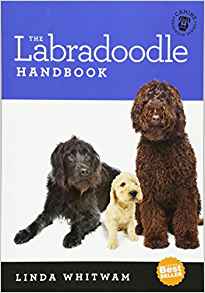
The Labradoodle Handbook
The Labradoodle basically refers to a Labrador Retriever cross with any Poodle, Standard, Miniature or Toy, though usually Standard Poodles are used. The name dates from the 1950s, but Labradoodles were popularised by Wally Conran, who was working with the Royal Guide Dogs Association of Australia in 1988. His idea was to develop a guide dog with the trainability of the Labrador, and the non-shedding coat of the poodle, so that the dogs would be suitable for people with allergies to dog fur and dander. He has since stated that he regrets ‘creating a Frankenstein’ and helping to create a fashion for designer breeds.
Labradoodles can vary a lot, both in terms of appearance, and temperament, because there´s so much variety among both Labradors and Poodles. Show and pet Labradors tend to larger and much more thick set than the more lightly built working dogs. Labradors are generally fun-loving, very bouncy as puppies and quick to learn, though working Labradors are much ‘busier’, with more need for exercise, and fit owners – or at least fit dog walkers! Yellow and black Labs are the two most common colours, though some people prize ‘chocolate’ Labs, and there has recently been a rise in popularity of the ‘fox red’ Labs, a colour usually associated with working Labs. They shed their coats, and, despite having short hair, their shedding can be quite prolific.
Standard Poodles are the tallest of the Poodles, and if you cross these with show-type Labs, the resulting dog is likely to be quite large and powerful, whereas a working Lab crossed with a Miniature Poodle is likely to be much smaller. Poodles also have a wide colour range. What is more important than colour, however, is that Standard Poodles in particular are prone to a range of disorders, especially auto-immune illnesses. Labradors, too, are prone to hip dysplasia, and eye problems, as are Standard and Miniature Poodles, so dogs from these breeds should be tested for hip dysplasia, and eye problems, if they are to be bred from.
The Australian Labradoodle club of Great Britain is active in seeking special status for the labradoodles descended from the original lines from Guide Dogs Association of Australia. The club rules for membership are set out very similarly those of most Kennel Club recognised breeds, however there is one rather striking clause in that breeders must ensure that no puppy is homed until neutered. Pre-pubertal neutering has drawbacks, so this will put some buyers off.
The appearance of Labradoodles can be quite irregular, with some dogs resembling either the shape of body, character and coat characteristics of either breed, in any combination. Some can even look quite terrier-like with a wiry textured coat. There’s no certainty that a Labradoodle’s coat will be non-shedding or easy care, and it may well be prone to matting. Regular grooming and trimming are essential. Choosing a Labradoodle, then is no guarantee of having an ‘easy care’ dog, or a dog that’s ‘hypnoallergenic’! In any case, it is the dander tends to cause problems for vulnerable people, so simply having a dog that’s non-shedding is no guarantee that its dander won’t trigger allergies.
Some breeders create first cross (F1) hybrids, while others breed Labradoodle to Labradoodle to obtain a more standardised type of dog. In both cases, it’s important to check that parents have been health-tested, given that both Poodles and Labradors can suffer from the same disorders. It’s especially important for F2 and subsequent crosses to be tested for common disorders, such as hip dysplasia, since ‘hybrid vigour’ is lost after the first cross.
Labradoodles tend to moult less than Labradors and they generally have a very gentle, playful and character as puppies. Both breeds are intelligent and trainable and generally make for nice, sociable fun-loving dogs, though dogs from working Labrador stock tend to be more intense. Labradoodles do involve a lot of commitment, first to find a healthy dog with a temperament that suits you, and secondly in terms of training. Your dog may look adorable in your eyes, but Labradoodles are big enough to knock people over with over-enthusiastic greetings! Training classes from puppyhood are a very good investment for people with Labradoodles.
Linda Whitwam´sThe Labradoodle Handbook deals with key issues relating to health and breeding in much greater detail than is possible here, and is generally a very useful reference book, best read before you have chosen a pup. There’s a lot of help with choosing a Labradoodle pup, as well as advice on training and management. Training is especially important for a large breed which can be quite bouncy, and the author stresses that these dogs are a major commitment. She notes that too many Labradoodles end up in rescue because all too often, people fall in love with cute pups, but don’t have enough time or energy to train large, energetic dogs. She has personal experience of the breed, and is a Labradoodle enthusiast, which comes across from the way she writes about Labradoodles. As with her The Cockerpoo Handbook, this is an informative reference book, rather than a collection of pretty pictures, though Linda Whitwam does discuss coat colours and variations as well as grooming.


